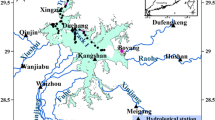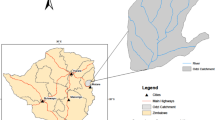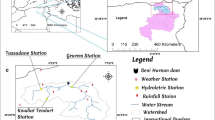Abstract
In this study, we built a two-dimensional sediment transport model of Lake Diefenbaker, Saskatchewan, Canada. It was calibrated by using measured turbidity data from stations along the reservoir and satellite images based on a flood event in 2013. In June 2013, there was heavy rainfall for two consecutive days on the frozen and snow-covered ground in the higher elevations of western Alberta, Canada. The runoff from the rainfall and the melted snow caused one of the largest recorded inflows to the headwaters of the South Saskatchewan River and Lake Diefenbaker downstream. An estimated discharge peak of over 5200 m3/s arrived at the reservoir inlet with a thick sediment front within a few days. The sediment plume moved quickly through the entire reservoir and remained visible from satellite images for over 2 weeks along most of the reservoir, leading to concerns regarding water quality. The aims of this study are to compare, quantitatively and qualitatively, the efficacy of using turbidity data and satellite images for sediment transport model calibration and to determine how accurately a sediment transport model can simulate sediment transport based on each of them. Both turbidity data and satellite images were very useful for calibrating the sediment transport model quantitatively and qualitatively. Model predictions and turbidity measurements show that the flood water and suspended sediments entered upstream fairly well mixed and moved downstream as overflow with a sharp gradient at the plume front. The model results suggest that the settling and resuspension rates of sediment are directly proportional to flow characteristics and that the use of constant coefficients leads to model underestimation or overestimation unless more data on sediment formation become available. Hence, this study reiterates the significance of the availability of data on sediment distribution and characteristics for building a robust and reliable sediment transport model.










Similar content being viewed by others
References
Akomeah E, Chun KP, Lindenschmidt K-E (2015) Dynamic water quality modelling and uncertainty analysis of phytoplankton and nutrient cycles for the upper South Saskatchewan River. Environ Sci Pollut Res 22(22):18239–18251
Alavian V, Jirka GH, Denton RA, Johnson MC, Stefan HG (1992) Density currents entering lakes and reservoirs. J Hydraul Eng 118(11):1464–1489
Ashmore P, Day T (1988) Spatial and temporal patterns of suspended-sediment yield in the Saskatchewan River basin. Can J Earth Sci 25(9):1450–1463
Asselman NEM (2000) Fitting and interpretation of sediment rating curves. J Hydrol 234(3):228–248
Binding C, Bowers D, Mitchelson-Jacob E (2005) Estimating suspended sediment concentrations from ocean colour measurements in moderately turbid waters; the impact of variable particle scattering properties. Remote Sens Environ 94(3):373–383
Boehrer B, Schultze M, Ockenfeld K, Geller W (2005) Path of the 2002 Mulde flood through Lake Goitsche, Germany. Internationale Vereinigung fur Theoretische und Angewandte Limnologie Verhandlungen 29(1):369–372
Bolstad E (2016) Extreme floods may be the new normal. Available at: http://www.scientificamerican.com/ article/extreme-floods-may-be-the-new-normal/, Accessed: 3 October 2016
Buchak EM, Edinger JE (1984) Generalized, longitudinal-vertical hydrodynamics and transport: development, programming, and applications. Technical report, prepared for US Army Corps of Engineers Waterways Experiment Station, Vicksburg, MS
Budd JW, Warrington DS (2004) Satellite-based sediment and chlorophyll a estimates for Lake Superior. J Great Lakes Res 30:459–466
Cardenas MP, Schwab DJ, Eadie BJ, Hawley N, Lesht BM (2005) Sediment transport model validation in Lake Michigan. J Great Lakes Res 31(4):373–385
Cole TM, Buchak E (1995) CE-QUAL-W2: a two-dimensional, laterally averaged, hydrodynamic and water quality model. US Army Engineer Waterways Experiment Station, Vicksburg, MS, 2.0 edn
Cole TM, Wells SA (2003a) CE-QUAL-W2: a two-dimensional, laterally averaged, hydrodynamic and water quality model. US Army Engineer Waterways Experiment Station, Vicksburg, MS, 3.1 edn
Cole TM, Wells SA (2003b) CE-QUAL-W2: a two-dimensional, laterally averaged, hydrodynamic and water quality model. US Army Engineer Waterways Experiment Station, Vicksburg, MS, 3.2 edn
Cole TM, Wells SA (2006) CE-QUAL-W2: a two-dimensional, laterally averaged, hydrodynamic and water quality model. US Army Engineer Waterways Experiment Station, Vicksburg, MS, 3.5 edn
Cole TM, Wells SA (2008) CE-QUAL-W2: a two-dimensional, laterally averaged, hydrodynamic and water quality model. Department of Civil and Environmental Engineering, Portland State University, Portland, OR, 3.6 edn
Cole TM, Wells SA (2013) CE-QUAL-W2: a two-dimensional, laterally averaged, hydrodynamic and water quality model. Department of Civil and Environmental Engineering, Portland State University, Portland, OR, 3.71 edn
Cole TM, Wells SA (2015a) CE-QUAL-W2: a two-dimensional, laterally averaged, hydrodynamic and water quality model. Department of Civil and Environmental Engineering, Portland State University, Portland, OR, 3.72 edn
Cole TM, Wells SA (2015b) CE-QUAL-W2: a two-dimensional, laterally averaged, hydrodynamic and water quality model. Department of Civil and Environmental Engineering, Portland State University, Portland, OR, 4.0 edn
De Vynck G, Polson J (2013) Suncor among Calgary offices closed amid severe Alberta floods. Available at: http://business.financialpost.com/news/suncor-among-calgary-offices-closed-amid-severe-alberta-floods, Accessed: 3 October 2016
Derworiz C (2016) Southern Alberta flood leads to ‘largest university-led water project in the world’. Available at: http://calgaryherald.com/news/national/southern-alberta-flood-leads-to-largest-university-led-water-project-in-the-world, Accessed: 3 October 2016
Dubourg P, North RL, Hunter K, Vandergucht DM, Abirhire O, Silsbe GM, Guildford SJ, Hudson JJ (2015) Light and nutrient co-limitation of phytoplankton communities in a large reservoir: Lake Diefenbaker, Saskatchewan, Canada. J Great Lakes Res 41:129–143
Eadie BJ, Schwab DJ, Johengen TH, Lavrentyev PJ, Miller GS, Holland RE, Leshkevich GA, Lansing MB, Morehead NR, Robbins JA et al (2002) Particle transport, nutrient cycling, and algal community structure associated with a major winter-spring sediment resuspension event in southern Lake Michigan. J Great Lakes Res 28(3):324–337
Edinger J, Buchak E (1975) A hydrodynamic, two-dimensional reservoir model: the computational basis. US Army Engineer Division, Ohio River. Cincinnati, OH
Edinger J, Buchak E (1978) Reservoir longitudinal and vertical implicit hydrodynamics. In: Proc. Int. Conf. on environmental effects of hydraulic engineering works, American society of civil engineers, Knoxville, TN
Fink G, Wessels M, Wüest A (2016) Flood frequency matters: why climate change degrades deep-water quality of peri-alpine lakes. J Hydrol 540:457–468
Giesy JP, Li PDS, Khim JS (2009) Water quality analysis report. Technical report, Toxicology Centre, University of Saskatchewan
Gippel CJ (1995) Potential of turbidity monitoring for measuring the transport of suspended solids in streams. Hydrol Process 9(1):83–97
Grove JR, Croke J, Thompson C (2013) Quantifying different riverbank erosion processes during an extreme flood event. Earth Surf Process Landf 38(12):1393–1406
Hecker M, Khim JS, Giesy JP, Li S-Q, Ryu J-H (2012) Seasonal dynamics of nutrient loading and chlorophyll a in a northern prairies reservoir, Saskatchewan, Canada. Journal of Water Resource and Protection 4(04):180
Horritt M (2006) A methodology for the validation of uncertain flood inundation models. J Hydrol 326(1):153–165
Huber A, Ivey GN, Wake G, Oldham CE (2008) Near-surface wind-induced mixing in a Mine Lake. J Hydraul Eng 134(10):1464–1472
Hudson JJ, Vandergucht DM (2015) Spatial and temporal patterns in physical properties and dissolved oxygen in Lake Diefenbaker, a large reservoir on the Canadian Prairies. J Great Lakes Res 41:22–33
Ji Z-G (2008) Hydrodynamics and water quality: modeling rivers, lakes, and estuaries. John Wiley & Sons
Klemm W, Greif A, Broekaert JA, Siemens V, Junge FW, Van der Veen A et al (2005) A study on arsenic and the heavy metals in the Mulde river system. CLEAN–Soil, Air, Water 33(5):475–491
Kroon FJ, Kuhnert PM, Henderson BL, Wilkinson SN, Kinsey-Henderson A, Abbott B, Brodie JE, Turner RD (2012) River loads of suspended solids, nitrogen, phosphorus and herbicides delivered to the Great Barrier Reef lagoon. Mar Pollut Bull 65(4):167–181
Langeveld J, Veldkamp R, Clemens F (2005) Suspended solids transport: an analysis based on turbidity measurements and event based fully calibrated hydrodynamic models. Water Sci Technol 52(3):93–101
Lee C, Schwab DJ, Hawley N (2005) Sensitivity analysis of sediment resuspension parameters in coastal area of southern Lake Michigan. Journal of Geophysical Research: Oceans 110(C3). doi:10.1029/2004JC002326
Lee C, Schwab DJ, Beletsky D, Stroud J, Lesht B (2007) Numerical modeling of mixed sediment resuspension, transport, and deposition during the March 1998 episodic events in southern Lake Michigan. Journal of Geophysical Research: Oceans 112(C2). doi:10.1029/2005JC003419
Lenzi MA, Marchi L (2000) Suspended sediment load during floods in a small stream of the Dolomites (northeastern Italy). Catena 39(4):267–282
Littlewood IG (1992) Estimating contaminant loads in rivers: a review. Institute of Hydrology (Centre for Ecology & Hydrology), Crowmarsh Gifford, Wallingford, Oxfordshire, OX1O 8BB
Liu G, Zhu J, Wang Y, Wu H, Wu J (2011) Tripod measured residual currents and sediment flux: impacts on the silting of the Deepwater Navigation Channel in the Changjiang Estuary. Estuar Coast Shelf Sci 93(3):192–201
Mama C, Okafor F (2011) Siltation in reservoirs. Nigerian Journal of Technology 30(1):85–90
Myint S, Walker N (2002) Quantification of surface suspended sediments along a river dominated coast with NOAA AVHRR and SeaWiFS measurements: Louisiana, USA. Int J Remote Sens 23(16):3229–3249
Pappenberger F, Matgen P, Beven KJ, Henry J-B, Pfister L, Fraipont P (2006) Influence of uncertain boundary conditions and model structure on flood inundation predictions. Adv Water Resour 29(10):1430–1449
Romero JR, Imberger J (2003) Effect of a flood underflow on reservoir water quality: data and three-dimensional modeling. Arch Hydrobiol 157(1):1–25
Sadeghian A, Hudson J, Wheater H, Lindenschmidt K (2014) Water quality modeling of Lake Diefenbaker. Water news Can Water Res Assoc 33(2):17–20
Sadeghian A, de Boer D, Hudson JJ, Wheater H, Lindenschmidt K-E (2015) Lake Diefenbaker temperature model. J Great Lakes Res 41:8–21
Sakmont Engineering (1987) A satellite imagery survey of land use in the effective drainage area of the South Saskatchewan River Basin. technical report d.2. Technical report, Consulting Hydraulic Engineers. Saskatoon, Saskatchewan
Saskatoon City News (2013) 2013 high river flow updates. Available at: www.saskatooncitynews.ca, Accessed: 28 June 2013
Stroud JR, Lesht BM, Schwab DJ, Beletsky D, Stein ML (2009) Assimilation of satellite images into a sediment transport model of Lake Michigan. Water Resour Res 45(2). doi:10.1029/2007WR006747
Surbeck CQ, Jiang SC, Ahn JH, Grant SB (2006) Flow fingerprinting fecal pollution and suspended solids in stormwater runoff from an urban coastal watershed. Environmental science & technology 40(14):4435–4441
Sutherland S (2016) Three years later: what caused the 2013 Alberta floods? Available at: https:// www.theweathernetwork.com/news/articles/why-was-southern-alberta-so-vulnerable-to-flooding-in-2013/29800, Accessed: 3 October 2016
Valero-Garces BL, Navas A, Machin J, Walling D (1999) Sediment sources and siltation in mountain reservoirs: a case study from the central Spanish pyrenees. Geomorphology 28(1):23–41
Vincent WF, Gibbs MM, Spigel RH (1991) Eutrophication processes regulated by a plunging river inflow. Hydrobiologia 226(1):51–63
Walling DE (1977) Limitations of the rating curve technique for estimating suspended sediment loads, with particular reference to British rivers. Erosion and solid matter transport in inland waters. IAHS Publ 122:34–48
Welsch E, De Vynck G (2013) Alberta floods spread as water subsides in Calgary. Available at: http //www.bloomberg.com/news/articles/2013-06-24/alberta-floods-spread-as-water-subsides-in-oil-hub-of-calgary, Accessed: 3 October 2016
Wetzel RG (2001) Limnology: lake and river ecosystems. Gulf Professional Publishing. 3rd edn
Wheater H, Evans E (2009) Land use, water management and future flood risk. Land Use Policy 26:S251–S264
Wheater H, Gober P (2013) Water security in the Canadian Prairies: science and management challenges. Philosophical Transactions of the Royal Society of London A: Mathematical, Physical and Engineering Sciences 371(2002):20120409
WSA (2012) State of lake diefenbaker. Water Security Agency. Available at: https://www.wsask.ca/Global/Lakes%20and%20Rivers/Dams%20and%20Reservoirs/Operating%20Plans/Developing%20an%20Operating%20Plan%20for%20Lake%20Diefenbaker/State%20of%20Lake%20Diefenbaker%20Report%20-%20October%2019%202012.pdf, Accessed: 21 May 2015
Wüest A, Imboden DM, Schurter M (1988) Origin and size of hypolimnic mixing in Urnersee, the southern basin of Vierwaldstättersee (Lake Lucerne). Schweizerische Zeitschrift für Hydrology 50(1):40–70
Yip H (2015) An assessment of present and historical (1984–2012) Lake Diefenbaker water clarity and chlorophyll-a concentration using Landsat imagery. Master’s thesis, University of Saskatchewan
Acknowledgements
This work was financially supported by the Canada Excellence Research Chair in Water Security through the Global Institute for Water Security. We thank Environment Canada, the Saskatchewan Water Security Agency, and Alberta Environment for providing the hydrometric and water quality data. We are grateful to MeteoBlue for providing the meteorological data. Thanks to the Limnology Laboratory at the University of Saskatchewan for providing the water turbidity and temperature data. Thanks also to the Department of Geography and Planning at the University of Saskatchewan for providing the bathymetry data.
Author information
Authors and Affiliations
Corresponding author
Additional information
Responsible editor: Marcus Schulz
Rights and permissions
About this article
Cite this article
Sadeghian, A., Hudson, J., Wheater, H. et al. Sediment plume model—a comparison between use of measured turbidity data and satellite images for model calibration. Environ Sci Pollut Res 24, 19583–19598 (2017). https://doi.org/10.1007/s11356-017-9616-y
Received:
Accepted:
Published:
Issue Date:
DOI: https://doi.org/10.1007/s11356-017-9616-y




